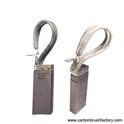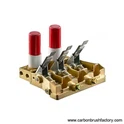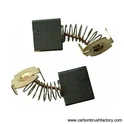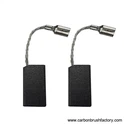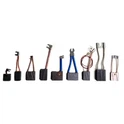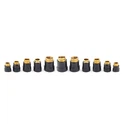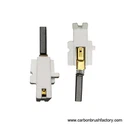1. From an intuitive point of view, the brush should be chamfered properly, the specifications should be appropriate, the structure should be standardized, the cross-section and length of the wire should meet the requirements, and there should be no loosening, falling off, breaking, falling edges, falling corners, clamps and other phenomena.
2. From the point of view of use, the signs of good brush performance are mainly as follows:
(1) Long service life and does not wear out the commutator or collector ring.
(2) It has good commutation and current collection performance, so that the spark is suppressed within the allowable range, and the energy loss is small.
(3) When the brush is running, it is not too hot, the noise is small, and it is not damaged.
(4) During operation, a uniform, moderate and stable oxide film can be formed on the surface of the commutator or collector ring quickly.
3. Detect the brushes through the instrument. From a technical point of view, the brushes should meet the standards issued by the national ministry. Through the instrument, the brush can be tested in accordance with the performance required by the "Brush Technical Performance Table". Such as the resistivity of the brush, Rockwell hardness, bulk density, current density, contact voltage drop, friction coefficient, 50-hour wear, allowable circumferential speed, unit pressure, and even the size of the metal content, etc.
4. On the same motor, you should choose to use the same type of brush from the same manufacturer. Due to the large differences in the performance of brushes produced by different manufacturing plants, even the performance of brushes produced by the same manufacturing plant at different times is also different. Therefore, for the same motor, the same model and the same manufacturer should be selected as much as possible, and it is best to produce brushes at the same time, so as to prevent the imbalance of the current distribution of parallel brushes caused by the difference in brush performance, which affects the normal operation of the motor.
5. For large and medium-sized motors with special difficulty in individual commutation, braided brushes can be selected. The aim is to improve commutation performance by increasing the short-circuit current within the brushes. For motors with difficulty in unidirectional rotation and commutation, combined brushes are an option. That is, choose to use graphite-based graphite-based graphite brushes with good lubrication performance and strong film-forming ability for the slide-in side, and choose to use carbon black-based graphite brushes with high resistivity with good commutation performance for the slide-out side. In this way, it is easy to form an oxide film, and it plays a great role in improving the commutation performance. Carbon fiber composite brushes can also be used on the sliding edge to highlight the characteristics of strong arc extinguishing ability, so as to achieve the best effect on the operation of the motor.

